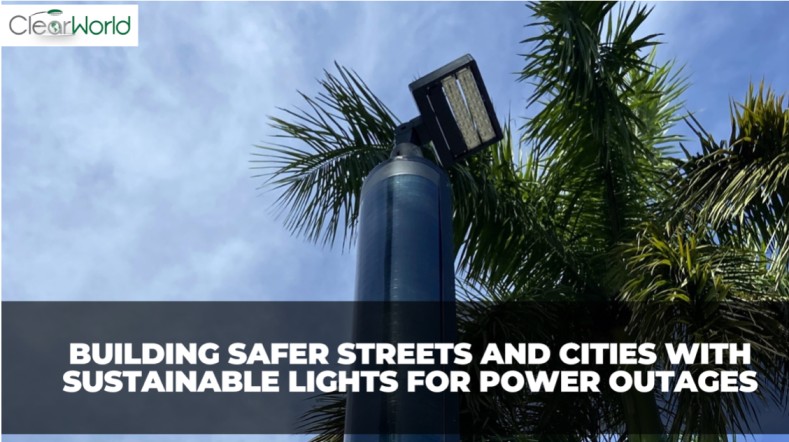Communities feel vulnerable when the power grinds to a halt. Darkness after a storm or a natural disaster adds to the feeling of uncertainty, creating some risk in matters of safety, mobility, and emergency response. Lights for Power Outages are now an essential need that keeps all cities or neighborhoods functioning in critical times. Whether it is light for a pathway for the first responders or light for public area buildings to stay safe during nights, dependable illumination can mean everything when an emergency strikes.
With an increase in the frequency of extreme weather events, hurricanes attacking the coasts, wildfires raging across dry landscapes, or snowstorms disrupting the transmission lines, the traditional power systems are proving their vulnerability. Solar street lights provide a dependable alternative to daylight into energy storage for usage when communities need it most. Together with renewable energy, these lights are at the forefront of creating resilience by offering sustainable solutions that can work independently of the grid.
Why Solar Street Lights Are Reliable in Emergencies?
There is a big history of evolution for solar street lighting. Present-day installations are prepared with high-capacity batteries, power-efficient LED bulbs, or heavy-duty mounts that provide running service under harsh weather. They are essential in disaster-prone areas where the grid might fail. Some of the core advantages are:
- Grid Independence: Solar-powered lights run on their own and provide uninterrupted light during an outage.
- Stored Energy Reserves: The present-day batteries can keep solar power for three to four nights to cover an extended outage.
- Low Maintenance and Longer Working Duration: LED fixtures and panels with tough design help keep maintenance minimal, an important factor in emergencies when repair crews could be stretched thin.
Resilience in the Face of Natural Disasters
Hurricanes and Coastal Storms
When a hurricane approaches, the first amenity to get destroyed is power lines. When infrastructure is brought down, it results in a blackout that could last for days or even weeks. Solar street lights keep functioning to guide the evacuees and provide lit paths to shelters and rescue teams. They work off-grid, so coastal communities are at least not left completely dependent on delayed utility repairs.
Wildfires and Extreme Heat
In places prone to wildfires, energy infrastructure is most often switched off in order to prevent the equipment from providing sparks on dry landscapes. Neighborhoods are, therefore, plunged into darkness when visibility is most crucial. Solar lights stand unaffected by this, illuminating without contributing to the fire hazard. They assure reliable illumination during mass evacuations, thereby ensuring order and security.
Snowstorms and Ice Events
Heavy snow and ice often overload power grids and cause power outages across large areas. Today, solar lights are manufactured with sealed batteries in weatherproof casings so that their use may be sustained even during subzero temperatures. They provide steady light during storm time, thereby reducing the pressure on emergency resources.
Practical Applications During Outages
Solar street lights offer more than basic illumination. In emergencies, they provide a network of reliable visibility that supports both residents and first responders. Key applications include:
- Safe Evacuation Routes: Bright, consistent lighting helps guide people away from danger zones.
- Operational Emergency Shelters: Parking lots and access roads remain lit, improving safety around temporary housing.
- Public Safety: Well-lit streets reduce risks of accidents and deter opportunistic crime during vulnerable moments.
Beyond Disaster: Long-Term Community Benefits
Sustainability and Savings
Aside from being invaluable during outages, solar street lights continue to create value. They save on electricity costs, cut down carbon emissions, and help in achieving larger environmental goals. That is a dual advantage for municipalities, whereby they also accrue long-term savings while becoming more able to resist future shocks.
Supporting Smart City Development
With the further growth of urban centers, the integration of renewable energy into public infrastructure becomes pertinent. Solar lights have sensors, communication nodes, and monitoring systems associated with them so that the combination offers multifunctionality. They enable cities to collect real-time data while providing dependable illumination.
Provision of Infrastructure in Remote Areas
Where it is impractical to extend the grid, or the cost of extra infrastructure is too high, solar street lights can provide the solution for guaranteed visibility at a fraction of the construction cost. This becomes especially relevant in rural areas prone to isolation during natural calamities.
Looking Ahead: Preparing for an Uncertain Climate Future
As climate challenges intensify, forward-thinking cities and communities seek solutions of resiliency and sustainability. All lighting retrofit to the existing infrastructure basically protects against power outages in the short term, while it promotes long-term independent power. From coastal towns bracing against hurricanes to wildfire-prone valleys, solar lighting is more than an afterthought key solution in future-proofing public safety.
Conclusion
In the evolving landscape of climate change and extreme weather, communities cannot afford to leave safety to chance. Lights for Power Outages are no longer optional; they are essential. Solar-powered street lights ensure that cities stay illuminated through hurricanes, wildfires, snowstorms, and beyond. By delivering reliable performance during blackouts while also supporting sustainability goals, they redefine resilience. As more regions adopt these systems, public spaces will remain safer, smarter, and better prepared for the challenges of tomorrow.

